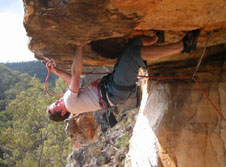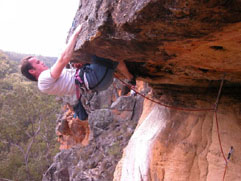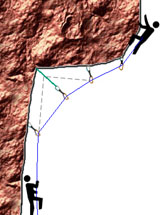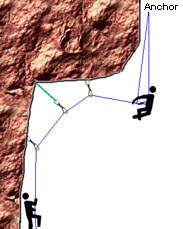Sponsored By
ROCK
HARDWARE
Leading Overhangs
 Contributed to Chockstone by Phil
Box, with excerpts from others.
Contributed to Chockstone by Phil
Box, with excerpts from others.
(Neither Phil, nor Chockstone takes any
responsibility for the accuracy of this article, or it's suitability for
the purpose. Use at your own risk.
Chockstone Photography | Landscape Photography Australia | Australian Landscape Photography
Please read the full disclaimer).
I used to struggle whilst coming to grips with climbing steep pitches, I still do to some extent. My true learning came when I installed a 9 metre lead roof 6 metres off the ground at my shed. This gave me the ability to analyse what was going on in my head in a safe environment.
Right: Neil Monteith on the roof of Pendulus (23), Red Cliffs, QLD. Photos by Phil. Diagrams below by Michael.
Climbing these daunting features is as much about what is happening inside your head as how far you can push yourself physically and technique. All three combine in an alliance of mind and body that truly will show you how you are wired up since birth. You will find things out about yourself that can only be revealed when you have a near death experience.
When Lee Skidmore and I started developing Redcliffs in the Helidon Hills, South East Queensland we gazed up at a geological formation that put the fear of God in us. Way up there 75 metres off the deck was this 3.5 metre roof that tipped down towards the lip, in other words it was overhung more than horizontal. When I first saw it I declared that this roof would never be possible to be climbed.
Of course we just had to throw a rope over it and check it out. Now around about here I have to declare that I am a huge wimp when it comes to abseiling, I just hate it, particularly when it comes to going over the edge so you can imagine if you will the terror when confronted with first going down to peek under this roof. I couldn't do it. I just had to stay on that lip but I did peek under the lip.
Next trip in we brought the stainless ringbolts and glued them in the appropriate places, Next day after the glue had set we started to work the route. That climb is steep right from the get go. Never mind the roof, how steep is the initial moves right off the belay ledge. There's a crimpy bulge to overcome first.
The thing about big fat ringbolts is that they do engender a sense of false courage but I still hate falling. I find out more and more that I am a control freak.
Lee and I take turns to push our limits and work the route, each of us push the route that little bit further towards the lip. By about 4 tries each we are poised to overcome the lip. I find a no hands rest within the bell chamber up in the ceiling, which helps tremendously and I am able to pull through the lip much to Lees disgust. Just as I have success in sight defeat is thrust upon me when I high step my foot on to the quickdraw. Instant flash pump engulfs me in a blinding panic and I simply cannot hang on and off I go into the void. Tragedy, I moan as Lee whoops it up.
Lee polishes off the rest of the moves to claim the
FFA and I am left to second and clean the draws. Oh the humility of it all.
The above story, which by the way is absolutely true, demonstrates some of what goes on in ones head during these types of climbs. Success can be a learned behaviour. On this climb we each learned through our own and each others mistakes. Mistakes are our friend, we learn to succeed through mistakes. Mistakes should not be cause for punishment, we should reward ourselves for making mistakes. Of course in our game some mistakes can kill us.
Right: Neil Monteith on the roof of Pendulus (23), Red Cliffs, QLD.
During the climb across the roof one should be absolutely focused on what ones feet are doing as well as how good your hands are gripping, never over grip. Don't even think about over climbing yourself. Over climbing is when one climbs ones feet up too high and you leave your hands behind. You will be exerting too much muscle energy in your arms. Think about body position and the relationship between your feet, hands and body. Try to climb on straight arms wherever possible.
Climbing on straight arms means that you will not be exerting muscle burning energy. Straight arms also means that you will be channelling all your energy through those big piston pumping hydraulic rams they call upper leg muscles.
Hands and fingers should only ever be used for delicate gripping and balance. Open hands will use less energy although I really like to crimp and have trained my fingers accordingly. Try not to over-grip as has already been stated. This is easier said than done particularly when it comes to roofs, overhangs and bulges because your mind is very much trying to exert a fight or flight influence.
Controlling what is going on in your mind is very much a factor of what you do in training. Getting on horizontal roofs and leading them is key to training your mind. I believe that there is a relationship with your inner ear and balance that has some influence in how well we react when confronted with very steep terrain. If you have trained the mind what to expect when coming up against this type of climbing then you are a considerable way towards overcoming the physical limitations of steep climbing.
 I climb occasionally with a guy who can crank like all
get out in the gym but take him outside and he breaks into a cold sweat
whenever confronted with anything even slightly steep. He climbs much better
than me in the gym but cries like a little girl outside, no names now, not
fair.
I climb occasionally with a guy who can crank like all
get out in the gym but take him outside and he breaks into a cold sweat
whenever confronted with anything even slightly steep. He climbs much better
than me in the gym but cries like a little girl outside, no names now, not
fair.
My head exposure problems have all but cleared up so much so that I recently suffered a 20 metre fall due to the casual attitude I had developed on multi-pitch routes. This of course is a warning to all that every part of climbing is directly linked with our survival. I believe that my head exposure problems cleared up because of the training I undertook that taught my head what to expect.
Right: Be careful of falling into the wall. Orientate yourself before cutting loose and bend your legs to absorb the impact. Contrary to the diagram depicted, you ideally would not leave the relative safety of the vertical wall without first clipping a piece out on the roof.
| "...The correct way to fall when on a roof. Just like a death traverse there is much chance of swinging in and smashing into the vertical bit under the roof in a roof lead fall. This can be stopped by the belayer giving out a few metres of slack before the fall. This means the climber falls down and is not swung into the wall fast from the last clipped bolt. This is very important to do on hard routes (i.e. Gorilla Tactics). It means you will fall a lot further but it is much better than smashing yourself head first into the wall which is really easy to do if you are twisted up in a roof climbing a cruxy section. Also be very careful not to get the rope twisted around your leg as you may fall off and get hung from your last foot. A big word of warning on roof flakes like Kachoong. Be careful not to jam your foot into a crack in the roof when you are getting desperate and pumped. Once your arms start giving up and you wont be able to un-jam your foot in the flake as the downwards pressure of you falling off will keep it there. You will fall off with your foot stuck above your head which can easily break your leg. This has happened numerous times on Kachoong!" - Neil Monteith. |
Body tension is talked about a lot and this also comes into your bag of tricks to overcome steep routes. The tension part relates to the push and pull between hands and feet and goes right through your stomach muscles. Have you ever seen someone doing a roof at the gym and they appear to be stiff as a board well that goes some of the way towards explaining body tension. Your whole body becomes involved in the movement and how your feet and hands connect to the rock.
When moving from a position to a long reach it is sometimes necessary to employ a toe hook to slow the swing down. Drop knees can be just as beneficial on roofs as they are on walls.
Strength and flexibility has only a marginal effect on how well someone can climb steep routes. We sometimes laugh at Jason Smith (Pommy) who can only achieve two pull ups with difficulty and can hardly touch his knees with his hands yet he can crank out grade 26 so go figure. There's no laughing then just jealousy.
Body position can be critical on occasion and reading the route helps you to know where the best position your body should be orientated. For instance, on Pendulus there is a right and easy way of pulling the lip and then there is everybody else's way, invariably the right way will see people pull the lip and the wrong way will see people spat off the lip. The difference is a grade 23 lip pull or a grade 26 lip pull.
 The thing is with this crux is that people get sucked
in to climbing across and as they approach the lip the tendency is to follow
the jugs and climb the feet towards the lip so that one ends up laying
parallel with the outside edge of the lip. This is good but people tend to
miss crucial jugs as their focus clouds and their footwork goes to potty and
the burn sets in which further narrows the focus. Body position is forgotten
about and that further messes with the whole equation of success.
The thing is with this crux is that people get sucked
in to climbing across and as they approach the lip the tendency is to follow
the jugs and climb the feet towards the lip so that one ends up laying
parallel with the outside edge of the lip. This is good but people tend to
miss crucial jugs as their focus clouds and their footwork goes to potty and
the burn sets in which further narrows the focus. Body position is forgotten
about and that further messes with the whole equation of success.
Right: Extend runners as appropriate to avoid rope drag.
I have seen climbers in the gym on roofs and they actually rotate their bodies a full 180 degrees to pull the next move rotating it back to again pull the move after that.
This is one area of climbing that can benefit greatly from a regime of training in the gym. Gym climbing on roofs is highly beneficial to success out on either sport or trad climbing really steep routes.
When climbing trad steep climbs time should be taken at rest spots to build really solid and redundant anchors for pro as the likelihood of falling is greatly enhanced and you may not be able to stop to put in all the gear that you would like.
Regaining Your High Point After A Fall
![]()
The good thing about falls on steep terrain is that you will ordinarily fall into air and not hit anything, scary but safe. Generally speaking if you fall on steep stuff and wish to regain your high point you can boink up the rope. Boinking is not what you think (get yer mind out of the gutter). You hand over hand up the rope creating a small amount of slack and then you boink up and obviously then fall back to the end of the rope but in the split second where there is no weight on the rope the belayer can yank a small amount of slack in. Repeat as often as necessary to get yourself back up to the belayers side of the rope.
Once at the belayers side of the rope you can then start to help by pulling down on the rope thus creating a sort of 2 to 1 pulley action through the top piece whether that be fixed pro or trad.
You can now choose to either rest, climb on or retreat. Resting is good as it clears the head and helps to attenuate the feelings of dread that one gets from hanging off that seemingly insignificant piece of nylon rope and having huge air beneath ones tail..
Relax for a bit and chill out dude, enjoy the view for a bit. Got your head together, you'll be amazed at your ability to carry on from this point. Continuing to lead out through a roof after a fall is key to future success in any endeavour that you put your mind to. Remember what we discussed at the start of this treatise, failure and mistakes are not to be punished, these are the things that ultimate success is built on.
Bailing Or Lowering Off & Retrieving Gear
![]()
Of course as in all things you have to make the call and you should never be afraid to back off and no one is going to make fun of you if you so choose. Better to back off than suffer an injury to either your physical body or your headspace. I do however counsel you to retain a have a go attitude but not to the extent of causing injury.
You will find that by pushing the limits safely that you will find new ways of achieving the objective. This can only be found by doing things that you never thought that you could do. It is highly recommended that climbing with someone who is very safety conscious and has already achieved some of what you are seeking is very beneficial.
Patience in both the leader and the belayer is definitely a virtue. Having a leader screaming obscenities is not conducive to good learning outcomes. Conversely if the belayer is goading the leader on with all manner of invective then that is unnerving and down right just not fair.
A good rapport between both is the answer in this situation so that helpful handy hints can be transmitted back and forth. Often the belayer can see what would be a good movement or a missed hold. Remember that focus narrows and often a leader will only see a narrow point of view. This is called tunnel vision and typically affects someone in a high stress situation. Having a cool guiding voice is very helpful in these circumstances.
Encouragement is the word too, a lot of people don't like much said at the crag but in this case I am suggesting that you are a team and should be climbing this beasty together as a team so voicing what needs to be said is to be encouraged.
Wanting to back off are we, good choice, it's just as valid as forging on. Anytime I see a leader make a choice to back off I shout up that he has made a good choice. Naturally I want him to succeed at his objective but his choice should be fully supported as to do otherwise would be to force a poor choice on to him and if it all goes pear shaped how would you live with yourself.
So we've made our choice to back off, we are faced with either down climbing which will enable us to clean as we go or we can leave all the gear in place for a subsequent attempt by either the leader or the belayer. We can also lower off our top piece of pro.
This last suggestion is fraught with danger if it is a trad lead. How does one back off a steep trad route and take all the gear with. Can't be done unless you have a stout tree to set up an abseil from. This is highly unlikely on roofs and overhangs but can be a possibility on bulges.
How is it that to set up a rap line people search around for big bomber trees or set up huge redundant anchors whereas if they want to bail from a route they will rap off the skimpiest piece of shoelace for tat.
True story this, found at Euglah Rock at Mt. Kaputar was a piece of 3mm accessory cord tied into a grape vine knot and wedged into a crack from which a party had obviously bailed from halfway up a route. This is death don't do this.
Build a bomber anchor from which to bail and don't be cheap with your life. As there are two of you the belayer may have more success in overcoming the difficulties that had beset you so he may be able clean the anchor that you bailed from and could head further out and up.
There is another possibility that should also be explored and that is the aiding option. Aiding should be in every climbers repertoire. When setting up a new roof route aiding is pretty much mandatory for work positioning. Aiding can get you out of a lot of sticky situations plus the good thing is that in trad you get to place a bunch of gear really close together.
Sport climbing protection is usually protection placed where there is no other pro available so aiding on these type of routes means that you simply pull on the draws. Clipping in to the fixed pro can be a way of having a rest and giving your belayer a rest as well.
If you have the luxury of climbing steep stuff on big
fat ringbolts then retreating off these routes is somewhat trivial. Just
clip in to the nearest ring and feed the rope through and lower off. Fixed
hangers may mean that you will have to leave a biner behind and carrots will
see you leaving a hanger and biner behind. Whilst lowering off one bolt you
will have to leave a biner or hanger and biner or for ringbolts feed the
rope through and lower off that.

Clip in to the side of the rope that is through all the protection. As you are either being lowered or are rapping you will stop and pull yourself into each piece of protection. Remove the pro and lower yourself back out or just take the big swing. Repeat until the route is clean. Note that this is not the best option as you are increasingly putting yourself at risk as you are relying on only one bolt. We've all done it but the warning must be given.
Right: When cleaning on lower (off a bomber anchor), the leader can clip a spare quickdraw between themselves and the rope, then pull into the next piece below. Removing the lowest draw can be a scary prospect given the pendulum swing. It may be safer to retrieve it later by climbing back up and then carefully down-climbing. The belayer should consider tying a stopper knot in the slack end of the rope to avoid it passing through their belay device.
The belayer can also pull you in by way of hauling on the rope going up to the anchor. Remember that you are clipped to the rope running up from the belayer to the lowering off point. As the belayer places tension on that side of the rope it will become relatively straighter thus drawing the climber back in towards the wall.
A big fat ring bolt can also accommodate a doubled over rope shoved through the hole to provide a means to lower out and retrieve a rope without the bother of feeding the whole rope through it. You would only do this if you hate taking the big swing like me, I'm a skirt when it comes to things like that.
Always climb with bail gear and self rescue equipment as well as a helmet, do as I say not as I do, I promise to heed my own advice in the future though.
Of course with all of the above advice do not actually go out and do any of it as there is an inherent risk attached with any activity associated with a cliff environment. As a matter of fact stay in front of your computer, oh wait there's radiation coming out of that screen you're staring into, better turn it off and put a crash hat on as there might be a meteor in the next million years that may or may not wipe out the whole population of the Earth.
Chockstone Feedback -
Discuss this article by leaving comments in an appropriate topic of the
forum.
Further Reading:
Trip Report - Link to the original trip report Pendulus progress.
Photo
Essay - Phil's photos of Neil's Pendulus ascent on rc.com.
Red
Cliffs - Link to pics of climbing at Redcliffs and includes pics of
Pendulus.
Home
| Guide | Gallery | Tech Tips | Articles | Reviews | Dictionary | Forum | Links | About | Search
Chockstone Photography | Landscape Photography Australia | Australian Landscape Photography
Please read the full disclaimer before using any information contained on these pages.
All text, images and video on this site are copyright. Unauthorised use is strictly prohibited.
No claim is made about the suitability of the information on this site, for any purpose, either stated or implied. By reading the information on this site, you accept full responsibility for it's use, and any consequences of that use.
